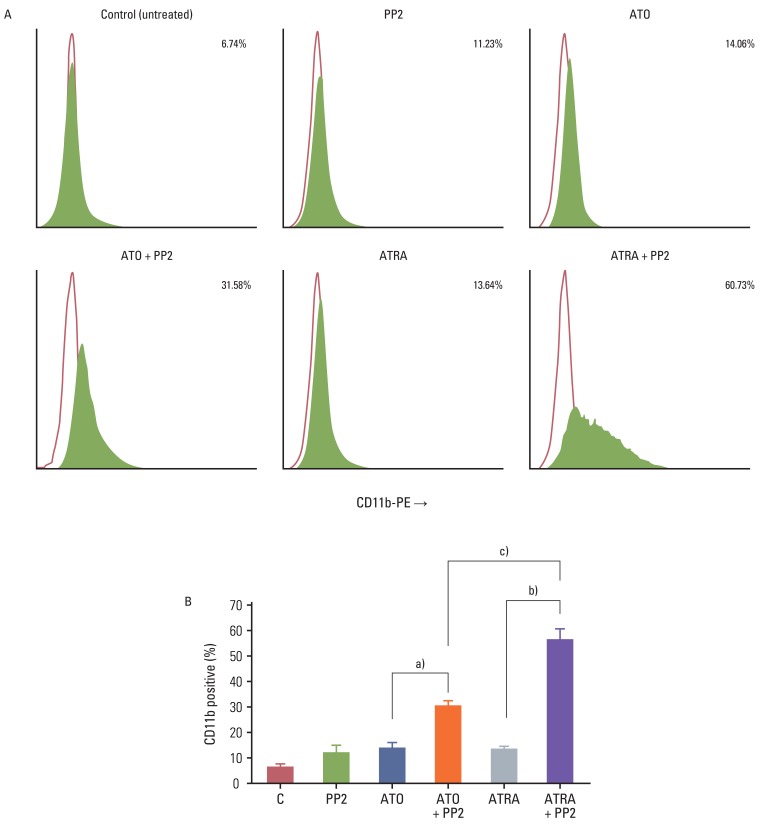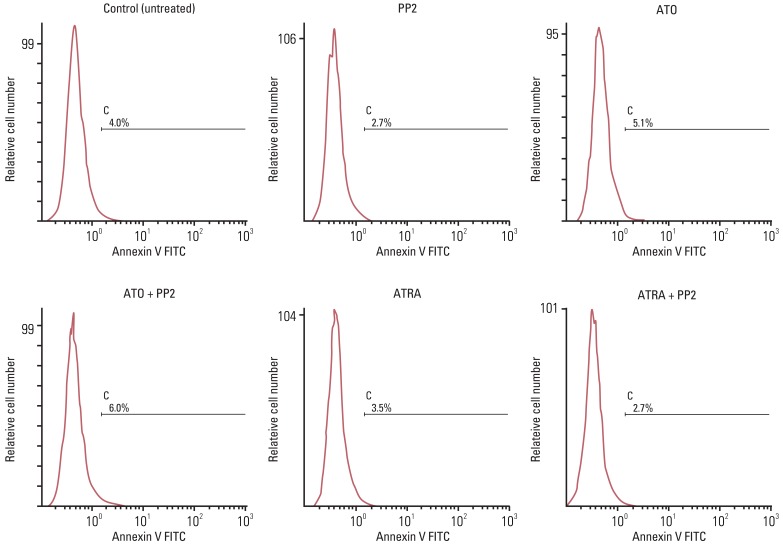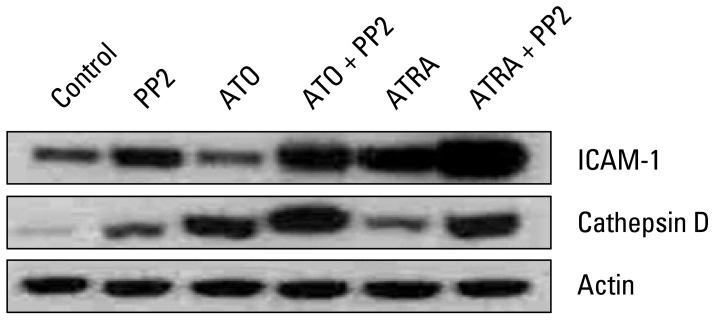Cancer Res Treat.
2013 Jun;45(2):126-133.
Src Family Kinase Inhibitor PP2 Has Different Effects on All-Trans-Retinoic Acid or Arsenic Trioxide-Induced Differentiation of an Acute Promyelocytic Leukemia Cell Line
- Affiliations
-
- 1Division of Hematology-Oncology, Department of Internal Medicine, Institute for Clinical Molecular Biology Research, Soonchunhang University Hospital, Soonchunhang University College of Medicine, Seoul, Korea. jhwon@schmc.ac.kr
Abstract
- PURPOSE
Leukemic promyelocytes have the unique ability to undergo differentiation after exposure to retinoic acid and both differentiation and apoptosis after exposure to arsenic trioxide (ATO). Recent studies have shown that inhibition of Src family kinases (SFKs) resulted in enhancement of retinoic acid-induced myeloid differentiation.
MATERIALS AND METHODS
In this study, we investigated the question of whether the SFK inhibitor PP2 enhanced the differentiation of NB4 cells when combined with ATO as well as when combined with all-trans-retinoic acid (ATRA). In addition, we attempted to determine the difference in retinoic acid-induced gene expression between cells treated with PP2 in combination with ATRA and in combination with ATO.
RESULTS
SFK inhibitor PP2 induced significant enhancement of ATRA- or ATO-induced differentiation of NB4 cells. A significantly stronger synergistic effect was observed when PP2 was combined with ATRA than when combined with ATO. Flow cytometric analysis demonstrated a significant increase in CD11b-positive granulocytes up to 60.73% and 31.58%, respectively. These results were confirmed by nitroblue tetrazolium staining. These effects were not related to apoptosis. Results of Annexin-V-fluorescein staining revealed that PP2 combined with ATRA or PP2 combined with ATO did not induce apoptosis in NB4 cells. Retinoic acid-induced gene expression was different in both groups. Intercellular adhesion molecule-1 expression showed a significant increase in cells treated with PP2 in combination with ATRA, whereas cathepsin D expression showed a significant increase in cells treated with PP2 in combination with ATO.
CONCLUSION
Our data showed that SFK inhibitor PP2 enhanced acute promyelocytic leukemia cell differentiation when combined with either ATRA or ATO with difference in activation of retinoic acid-induced genes.
Keyword
MeSH Terms
-
Apoptosis
Arsenic
Arsenicals
Cathepsin D
Cell Differentiation
Cell Line
Gene Expression
Granulocyte Precursor Cells
Granulocytes
Humans
Intercellular Adhesion Molecule-1
Leukemia, Promyelocytic, Acute
Nitroblue Tetrazolium
Oxides
Phosphotransferases
Pyrimidines
src-Family Kinases
Tretinoin
Arsenic
Arsenicals
Cathepsin D
Intercellular Adhesion Molecule-1
Nitroblue Tetrazolium
Oxides
Phosphotransferases
Pyrimidines
Tretinoin
src-Family Kinases
Figure
Reference
-
1. Kim MP, Park SI, Kopetz S, Gallick GE. Src family kinases as mediators of endothelial permeability: effects on inflammation and metastasis. Cell Tissue Res. 2009; 335:249–259. PMID: 18815812.
Article2. Pene-Dumitrescu T, Smithgall TE. Expression of a Src family kinase in chronic myelogenous leukemia cells induces resistance to imatinib in a kinase-dependent manner. J Biol Chem. 2010; 285:21446–21457. PMID: 20452982.
Article3. Danhauser-Riedl S, Warmuth M, Druker BJ, Emmerich B, Hallek M. Activation of Src kinases p53/56lyn and p59hck by p210bcr/abl in myeloid cells. Cancer Res. 1996; 56:3589–3596. PMID: 8758931.4. Klejman A, Schreiner SJ, Nieborowska-Skorska M, Slupianek A, Wilson M, Smithgall TE, et al. The Src family kinase Hck couples BCR/ABL to STAT5 activation in myeloid leukemia cells. EMBO J. 2002; 21:5766–5774. PMID: 12411494.
Article5. Chen Y. Are SRC family kinases responsible for imatinib- and dasatinib-resistant chronic myeloid leukemias? Leuk Res. 2011; 35:27–29. PMID: 20723974.
Article6. Dos Santos C, Demur C, Bardet V, Prade-Houdellier N, Payrastre B, Recher C. A critical role for Lyn in acute myeloid leukemia. Blood. 2008; 111:2269–2279. PMID: 18056483.
Article7. Kropf PL, Wang L, Zang Y, Redner RL, Johnson DE. Dasatinib promotes ATRA-induced differentiation of AML cells. Leukemia. 2010; 24:663–665. PMID: 20033056.
Article8. Guerrouahen BS, Futami M, Vaklavas C, Kanerva J, Whichard ZL, Nwawka K, et al. Dasatinib inhibits the growth of molecularly heterogeneous myeloid leukemias. Clin Cancer Res. 2010; 16:1149–1158. PMID: 20145167.
Article9. Mermel CH, McLemore ML, Liu F, Pereira S, Woloszynek J, Lowell CA, et al. Src family kinases are important negative regulators of G-CSF-dependent granulopoiesis. Blood. 2006; 108:2562–2568. PMID: 16772601.
Article10. Harder KW, Parsons LM, Armes J, Evans N, Kountouri N, Clark R, et al. Gain- and loss-of-function Lyn mutant mice define a critical inhibitory role for Lyn in the myeloid lineage. Immunity. 2001; 15:603–615. PMID: 11672542.
Article11. Miranda MB, Redner RL, Johnson DE. Inhibition of Src family kinases enhances retinoic acid induced gene expression and myeloid differentiation. Mol Cancer Ther. 2007; 6(12 Pt 1):3081–3090. PMID: 18065491.
Article12. Wang ZY, Chen Z. Acute promyelocytic leukemia: from highly fatal to highly curable. Blood. 2008; 111:2505–2515. PMID: 18299451.
Article13. Tallman MS, Altman JK. How I treat acute promyelocytic leukemia. Blood. 2009; 114:5126–5135. PMID: 19797519.
Article14. Miranda MB, Johnson DE. Signal transduction pathways that contribute to myeloid differentiation. Leukemia. 2007; 21:1363–1377. PMID: 17443228.
Article15. Corey SJ, Anderson SM. Src-related protein tyrosine kinases in hematopoiesis. Blood. 1999; 93:1–14. PMID: 9864140.
Article16. Congleton J, MacDonald R, Yen A. Src inhibitors, PP2 and dasatinib, increase retinoic acid-induced association of Lyn and c-Raf (S259) and enhance MAPK-dependent differentiation of myeloid leukemia cells. Leukemia. 2012; 26:1180–1188. PMID: 22182854.
Article17. Park KB, Hong DS, Suh WS, Lee NS, Park SG, Won JH, et al. Arsenic trioxide (As2O3) induced apoptosis in NB4 cell lines. Korean J Hematol. 2002; 37:200–211.18. Soignet SL, Maslak P, Wang ZG, Jhanwar S, Calleja E, Dardashti LJ, et al. Complete remission after treatment of acute promyelocytic leukemia with arsenic trioxide. N Engl J Med. 1998; 339:1341–1348. PMID: 9801394.
Article19. Cai X, Shen YL, Zhu Q, Jia PM, Yu Y, Zhou L, et al. Arsenic trioxide-induced apoptosis and differentiation are associated respectively with mitochondrial transmembrane potential collapse and retinoic acid signaling pathways in acute promyelocytic leukemia. Leukemia. 2000; 14:262–270. PMID: 10673743.
Article20. Lombardo LJ, Lee FY, Chen P, Norris D, Barrish JC, Behnia K, et al. Discovery of N-(2-chloro-6-methyl-phenyl)-2-(6-(4-(2-hydroxyethyl)-piperazin-1-yl)-2-meth-ylpyrimidin-4-ylamino)thiazole-5-carboxamide (BMS-354825), a dual Src/Abl kinase inhibitor with potent antitumor activity in preclinical assays. J Med Chem. 2004; 47:6658–6661. PMID: 15615512.
- Full Text Links
- Actions
-
Cited
- CITED
-
- Close
- Share
- Similar articles
-
- Salvage treatments with all-trans retinoic acid and arsenic trioxide-based regimens in acute promyelocytic leukemia
- Remission induction using arsenic trioxide in acute promyelocytic leukemia
- A Case of Relapsed Acute Promyleocytic Leukemia Induced Remission with Arsenic Trioxide(As2O3)
- Anticancer Effect of Arsenic Trioxide in Acute Promyelocytic Leukemia
- All-trans Retinoic Acid induced Myositis in a Patient with Acute Promyelocytic Leukemia





